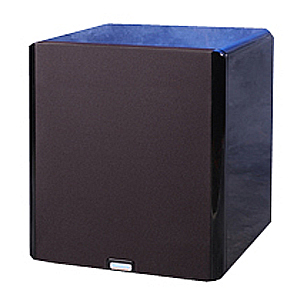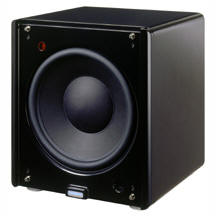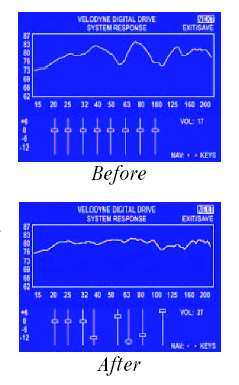You are reading the older HTML site
Positive Feedback ISSUE
16
november/december 2004
velodyne
DD-15 subwoofer
as reviewed by Danny Kaey

|
DANNY KAEY'S SYSTEM LOUDSPEAKERS ELECTRONICS SOURCES CABLES
|
Dave Clark has done an excellent job of covering the benefits of adding a super tweeter to an audio system. I will attempt to do the same for subwoofers, specifically the awesome Velodyne DD-15. The world of bass is difficult to cope with properly. Many articles have been written on the subject, by people who have far more understanding of the difficulties than I. Do a Google search, and you will be kept busy for weeks, sifting through articles, charts, and graphs. I will stick to layman's terms, in an effort to keep things simple.
Ideally, all loudspeakers would be full range, but therein lie several dilemmas. The first is a matter of physics. You need to move lots of air in order to reproduce the lowest of notes, which means that you will need large drivers (or surface membranes) as well as large cabinets, and large cabinets are no good unless they have been superbly constructed, with proper bracing to withstand the pressures being generated by the drivers. A pair of such loudspeakers costs a lot of money. The second issue is that your room will play all sorts of evil tricks on you, especially in the bass. While the short length of high-frequency sounds can be fairly easily delivered to your listening position with accuracy, the same cannot be said about bass. This is because of standing waves produced within your room that double and quadruple certain bass frequencies, to the point that you will probably prefer to return to listening to mini-monitors. Suckouts also occur, in which, due to the shape and size of your room, certain portions of the bass frequency spectrum are cancelled out entirely. No amount of equalization can eliminate this problem.
As you can see, producing authoritative bass is much more of a problem than most of us wish for. Nevertheless, I am a bass kind of a guy. I don't mean the boom-boom-boom you hear coming from the souped-up pocket rocket standing next to you at the traffic light. No, by bass I mean the sound of bass-heavy instruments. What the owners of those pocket rockets think is bass is really nothing more than upper midbass, say around 100Hz or so. Truly low bass can't be heard. Rather, you feel it by virtue of your walls shaking or the room rattling.
align="justify" style="margin-left: 10px; margin-right: 10px">

Imagine hearing a large-scale symphony orchestra in all its glory—feeling the kick drum being whacked, or the crescendo of the orchestra, is something every audiophile should experience at least once, even if you can't live with it day in and day out. While I can appreciate the sound of high-quality small speakers (and there are some really, really great ones), I don't get jumping until I hear full-range sound. My Marten Design Miles II loudspeakers are no slouches in the bass department. They have useful bass down to about 4dB at 30Hz, and boy, are they quick and resolving! Listening to my favorite full-range music, I never really feel that I am missing anything. They are capable of resolving most bass lines in superb, articulate fashion. They never muddle or thicken the sound, and their bass feels right. It is only by directly comparing them to TRULY full-range loudspeakers that I know something's missing.
In my room, I have a 10dB suck out at 60Hz as well as a bass hump of a couple dB at 30hz. Using larger loudspeakers would only compound these problems while doing little to solve them. Adding a subwoofer is the only solution, but finding the right one and setting it up properly is difficult. My fears about setup were always along the lines of "How much should I turn up the bass volume?" "How will I know that the bass output of the sub will match the characteristics of my main speakers?" Perhaps the most awesome and widely recognized system ever to have graced a living room was the Mark Levinson-designed HQD system, which came to life in the mid 70s. Levinson was looking for awe-inspiring, real-life dynamics, and came up with a system to pair his stacked Quad 57s—arguably the best midrange speaker in the world—with a pair of ribbon tweeters and a servo-controlled subwoofer system. The few lucky owners were in for a real treat. Bass extension was simply stunning, and nothing short of magic.
Meanwhile, Velodyne, a small and inventive American company, was beginning to develop practical and well-engineered subwoofer systems. In the years since, Velodyne has developed many revolutionary subwoofers. The latest is their Digital Drive series, launched a few years ago with the appropriately named 1812 system. The 1812, which is still in production, consists of a dual sealed driver system housing an 18-inch and a 12-inch driver with servo control, a digital switching power amp delivering 5 kilowatts of power, and an ingenious digital room correction system. The bass generated by this 800-pound Godzilla, which is flat down to infrasonic levels of around 7Hz, is awe inspiring and glass shattering, yet with unbelievable delicacy and control. The benchmark for any subwoofer is how well it will integrate with Quad 57s. Why? Because the Quad's super-thin membranes are so quick to react to the input signal that few subwoofers are capable of following their lead, resulting in a slowing of pace, a lack of synergy, and an overall degradation of performance. While many subwoofers will fail in this context, the Velodyne Digital Drive subs are one among them. Control of the driver is accomplished by a 1.2-kilowatt digital switching amp, coupled with a clever Texas Instruments control chip that offers adjustable servo control.
 In researching
subwoofers, I discovered that while there are dozens of audiophile subwoofer
systems out there (audiophile as opposed to video subs, which typically are
all about KABOOM rather than the truthful reproduction of bass), few address
the issues in a 2004 sort of way. I often feel that the audio industry is
sleeping when it comes to delivering on new technology. The reason that
Velodyne's DD series literally jumped out at me was that it offered full
customizable adjustability and computer-assisted setup. Resting at the top
of the line of subwoofer systems, the DD series consists of four models.
There is a 10-inch model, a 12-inch, a 15-inch, and a mighty 18-inch sub.
Each system is powered by a 1250-watt digital power amp, a servo control
system, a digital parametric eight-band EQ with an infinitely adjustable low
pass filter, throughput daisy chain options (you can link multiple pairs of
individually adjusted and room corrected DD subs), a built-in test tone
generator, a specially designed and calibrated microphone to measure your
room in real time, a video output to display your room graphically on your
television set, a multitude of installation options, and last but not least,
a very thoughtful owners manual.
In researching
subwoofers, I discovered that while there are dozens of audiophile subwoofer
systems out there (audiophile as opposed to video subs, which typically are
all about KABOOM rather than the truthful reproduction of bass), few address
the issues in a 2004 sort of way. I often feel that the audio industry is
sleeping when it comes to delivering on new technology. The reason that
Velodyne's DD series literally jumped out at me was that it offered full
customizable adjustability and computer-assisted setup. Resting at the top
of the line of subwoofer systems, the DD series consists of four models.
There is a 10-inch model, a 12-inch, a 15-inch, and a mighty 18-inch sub.
Each system is powered by a 1250-watt digital power amp, a servo control
system, a digital parametric eight-band EQ with an infinitely adjustable low
pass filter, throughput daisy chain options (you can link multiple pairs of
individually adjusted and room corrected DD subs), a built-in test tone
generator, a specially designed and calibrated microphone to measure your
room in real time, a video output to display your room graphically on your
television set, a multitude of installation options, and last but not least,
a very thoughtful owners manual.
I got in touch with Kurt, the gentleman in charge of media requests and service, among other things, at Velodyne. Shortly thereafter, a brand new Velodyne DD-15 was at my door. Kurt thought that the DD-18 would be too powerful for my room, and the DD-12 just shy of optimal. Due to the superbly simple and effective setup and installation process, I was up and running in no time. You simply plug the microphone into the sub, connect the video output to your TV monitor (Velodyne could have also added a DVI output connector), run the sub via a second set of main outs through your preamp, and you are pretty much there. Even though Velodyne offers several pre-selected scenarios for the subwoofer, which are easily available through the remote control, the DD-15 deserves proper setup and calibration. A major plus of the DD series is that you have instant visual display of your room's bass response via the onboard sweep generator, which repeatedly cycles a 20 to 200Hz sine wave. "Wow!" is pretty much what you will say once you are able to actually see the bass problems of your room.
At first, I set the DD-15 between my main speakers, figuring that would be a good position. Boy, was I wrong! I was able to instantly verify the results on my video monitor, which showed that although the bass registered an all-time low of 15Hz, my bass suckout was even more pronounced. The parametric EQ allows for a cut of 12dB but only a modest 6dB boost, to eliminate the possibility of overdriving the amp and, of course, the sub. No amount of bass boost will ever cure a suckout, so I didn't bother trying. I then tried pushing the DD-15 into the corner—usually the sweet spot for a sub—while maintaining visual cues about the real-time bass alignment. After some experimenting, I found the best spot to be about one foot off the rear wall and six feet from the adjacent wall, with the sub pointed diagonally into the room. This setup proved to be magical, and required little tinkering with the phase and polarity settings. The only adjustments necessary were proper calibration of the built-in EQ, and that only to cut certain peaks. I applied a moderate amount of boost at the lowest EQ point of 20 cycles, and the display showed a virtually flat response down to 15Hz! Amazingly, the suckout problem had completely vanished, and I now had amazingly flat bass response.
Listening to the sine wave sweep for a prolonged time becomes somewhat dull, even if it results in astonishing room calibration, so I played my favorite bass test, track two on Mino Cinelu's debut album. (Nino is Sting's percussionist.) This is where it becomes difficult to convey the message through written words, since nothing—and I mean NOTHING—prepared me for what happened. The bass was so powerful and real that it took me a while to just grasp the idea that I was listening to a truly full-range system. I went back to the beginning of the track just to make sure that I wasn't imagining things, and was again smacked back into my chair from the sound pressure being generated by the DD-15. Flappiness or boominess? No way. The servo control was set to its highest setting of 8 (the recommended setting for music playback), and absolutely none of my favorite bass tracks was able to get the sub to misbehave. Each time the results were the same—the bass was so realistic and convincing that it was downright frightening. Make sure you have a talk with your neighbors before setting up this sub, since they might feel compelled to call 911.
 The improvements were
not restricted to the bass. My Martens, now relieved from handling the
lowest frequencies, opened up quite a bit. This was especially noticeable
during big orchestral crescendos and other bass heavy material. Turning off
the DD-15 again made the Martens sound like they were working overtime.
Reinserting the DD-15 instantly transformed the system, giving it an
openness and airiness that the Martens alone could not achieve. Bill
Laswell's Dub Chamber 4: Book of Exit, a favorite of mine, showed
tremendous improvement when played back with the DD-15. Bass now filled the
room with so much energy and force that it was an event. The lower registers
had clarity and focus, instilling calmness into the performance. Overhang
and bloat was nowhere in evidence. Another good example was Classic Record's
excellent remaster of Bizet's Carmen on RCA. The lovely and
rhythmically involving performance benefited tremendously from the DD-15.
Loud and voluminous crescendos blasted off to the moon, providing the
necessary boost in the lower frequencies. The Martens again opened up
nicely, with a larger soundstage. The stage seemed to stretch way beyond the
parameters of my listening room, and it was simply magnificent. Instruments
now seemed to mesh more easily with the rhythm section, and suffered no
congestion or compression.
The improvements were
not restricted to the bass. My Martens, now relieved from handling the
lowest frequencies, opened up quite a bit. This was especially noticeable
during big orchestral crescendos and other bass heavy material. Turning off
the DD-15 again made the Martens sound like they were working overtime.
Reinserting the DD-15 instantly transformed the system, giving it an
openness and airiness that the Martens alone could not achieve. Bill
Laswell's Dub Chamber 4: Book of Exit, a favorite of mine, showed
tremendous improvement when played back with the DD-15. Bass now filled the
room with so much energy and force that it was an event. The lower registers
had clarity and focus, instilling calmness into the performance. Overhang
and bloat was nowhere in evidence. Another good example was Classic Record's
excellent remaster of Bizet's Carmen on RCA. The lovely and
rhythmically involving performance benefited tremendously from the DD-15.
Loud and voluminous crescendos blasted off to the moon, providing the
necessary boost in the lower frequencies. The Martens again opened up
nicely, with a larger soundstage. The stage seemed to stretch way beyond the
parameters of my listening room, and it was simply magnificent. Instruments
now seemed to mesh more easily with the rhythm section, and suffered no
congestion or compression.
Most of the subs I have come across in the past year or so simply didn't provide this kind of realism. All exhibited some form of boominess and over-emphasis of the lowest registers. Most consumers perceive this kind of bass as correct, but reference to the measured room response will exhibit too much boost in the mid- to upper bass. The lowest notes should sound appropriate, and should appear only when the recording has actually captured them. With the DD-15, images have a sense of harmony and connectivity that only the most expensive speaker systems can deliver. Each CD I played exhibited a cohesiveness that truly brought the performers together, with the DD-15 acting like a magic adhesive. There were no side effects. No seams were heard or felt. While the system sounded great before the DD-15's arrival, it sounded magical with it in place.
Surely I must have some complaints, no? Not really. The DD-15 is beautifully made, with three finishes available—maple, cherry, and high-gloss black. Mine is the black high-gloss, and it is impeccable. The back panel, which houses the electronics, is removable, which makes upgrading or service easy. The subwoofer performed without any hitches or flaws. This is an amazing subwoofer, the best I have ever come across, and while expensive, it is reasonably priced for such a technological tour de force. You will appreciate all of the technology from the first moment, as you will be able to easily and expertly calibrate the sub for your room. Not many (if any) full-range speaker systems can offer flat response to 15Hz, at any price. For around $14,000 ($10K for the Martens and $4K for the DD-15), I feel that I now have a full-range system that is second to none. I applaud Velodyne for offering so much technology with a simple-to-use interface. I wish that more manufacturers would follow this approach, though I do know of a handful of manufacturers who will be doing just this in the near future.
There are only a few products I feel so strongly about that I consider them to be must-have items. The Brinkmann LaGrange turntable is one of them, the Loricraft record cleaning machine another. The Velodyne DD-15 so clearly and easily shows its superiority that you simply must listen to, or better yet, purchase one. I can't imagine going back to listening to music without it. Danny Kaey
DD-15 subwoofer
Retail: $4000
Velodyne
web address:
www.velodyne.com
